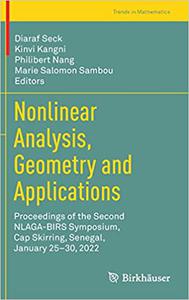
Nonlinear Analysis, Geometry and Applications
English | 2022 | ISBN: 3031046153 | 480 Pages | PDF EPUB (True) | 62 MB
- Stability Analysis and Uniform Persistence of the Dynamics of Cytotoxic Cells with Crowley-Martin Functional Response. - Null Controllability by Birth Control for a Population Dynamics Model. - Aedes Vertical Transmission Logistic Growth Mathematical Model for Assessing Arboviruses Maintenance in Environment: A Positive Semigroup Approach. - Global Dynamics of a Spore Producing Pathogens Epidemic System with Nonlocal Diffusion Process. - Stochastic Reaction Network Modeling and Optimal Control for Covid-19. - Bayesian Selection of Adaptive Bandwidth in Non-homogeneous Poisson Process Kernel Estimators for the Intensity Function. - Nonnegative Matrix Factorization and Log-Determinant Divergences. - Study of the Shallow Water Equations with Variable Bathymetry in a Channel with Flather Open Boundary Condition. - Almost Periodic Solution for Non Autonomous Non Densely Defined Cauchy Problems. - Homogenization of a Parabolic Equation with Random Coefficients: An Application to Sand Transport Equations. - Uniqueness and Stability in an Inverse Problem for Electromagnetic Forming of a Metal Jet. - Numerical and Theoretical Analysis for Optimal Shape Inverse Problems. - Algorithms for Nonlinear Integral Equations of Hammerstein Type with Phi-monotone Mappings in Certain Banach Spaces. - A Riemannian Point of View for a Quadrature Surface Free Boundary Problem. - A Study of Sharp Coefficient Bounds for a New Subfamily of Starlike Functions. - Resolution of d¯d for Differential Forms with Boundary Value in the Sense of Currents Defined on a Half Space of Cn. - Certain Contributions to the ¯d -Problem. - Self-intersection on Pair of Pants. - On the Closure of Irregular Orbits of the Horocyclic Flow. - Central Extensions and Hom-Quadratic Hom-Novikov Color Algebras. - On the Topology of the Intersection Curve of Two Real Parameterized Algebraic Surfaces. - Algebraic Points of Any Degree on the Affine Curve y2 = x(x2 + 1)(x2 + 3).



